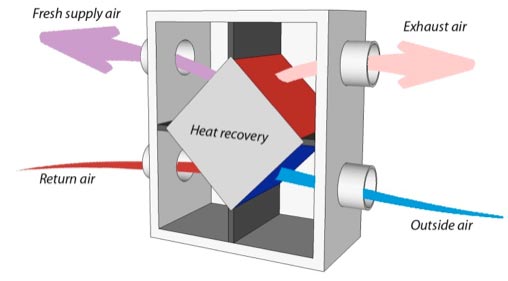Simple Tips to Maximize HRV Efficiency
Wiki Article
Checking out the Advantages of Heat Recovery Ventilation for Energy Efficiency in Homes
Heat Recovery Ventilation (HRV) systems supply house owners a sensible technique to improving energy performance. By redeeming warm from outward bound air, these systems can significantly lower cooling and heating prices. Furthermore, they provide a consistent supply of fresh air, boosting interior air quality and convenience levels. As homeowners take into consideration lasting choices, comprehending the nuances of HRV systems becomes significantly important. What variables should one assess prior to making such an investment?Understanding Heat Recovery Ventilation Systems

Just How HRV Enhances Indoor Air High Quality

Energy Financial Savings: The Monetary Benefits of HRV
Making the most of power efficiency, heat recovery ventilation (HRV) systems supply significant economic advantages for property owners. By recovering and recycling warmth from exhaust air, HRVs noticeably lower heating & cooling expenses. This innovation can cause power financial savings of approximately 30%, depending upon environment and usage patterns. House owners often discover decreased energy expenses soon after setup, making HRVs a monetarily wise investment with time. Additionally, lots of areas provide motivations or discounts for energy-efficient upgrades, additionally improving the financial charm. As power costs remain to rise, the cost-effectiveness of HRVs becomes significantly clear. Overall, the incorporation of HRV systems not only advertises energy efficiency yet also adds to lasting monetary cost savings for homes.The Ecological Impact of Heat Recovery Ventilation
A considerable ecological benefit of heat recovery ventilation (HRV) systems hinges on their ability to reduce total power usage. By redeeming warmth from exhaust air and transferring it to inbound fresh air, HRV systems minimize the requirement for energy-intensive heating and cooling down methods. This reduction in energy demand contributes to decrease greenhouse gas discharges, as less nonrenewable fuel source is needed to maintain comfy indoor temperature levels. Furthermore, HRV systems enhance indoor air top quality by successfully trading stagnant air with fresh outside air, reducing reliance on mechanical air conditioning systems that can damage the environment. In general, the application of HRV systems supports sustainable living practices and lines up with international initiatives to battle climate modification by promoting energy performance in property setups.
Selecting the Right HRV System for Your Home
How can house owners ensure they select the best heat recovery ventilation (HRV) system for their demands? First, they need to assess their home's dimension and layout, as these elements affect air movement requirements. Next, reviewing the system's efficiency ratings is crucial, as higher ratings indicate better performance and power cost savings. Property owners should also consider installment and upkeep costs, comparing various brand names and versions for value. Additionally, it is very important to review noise levels, as some systems run more silently than others. Consulting with cooling and heating experts can give customized referrals based upon specific home problems. Taking a look at individual testimonials and service warranties can aid in making an informed choice, making sure that the selected HRV system successfully improves interior air high quality and energy performance.Often Asked Inquiries

How Typically Should I Tidy or Preserve My HRV System?
The regularity of cleaning or preserving a heat recuperation ventilation (HRV) system usually relies on usage and environmental factors. Generally, it is a good idea to execute upkeep every 6 months to assure peak efficiency and air quality.
Can HRV Systems Help Decrease Humidity Levels Indoors?
HRV systems can successfully minimize interior humidity levels by trading stagnant, humid air with fresh, drier air from outdoors. HRV Heat Recovery Ventilation. This process aids keep a well balanced indoor atmosphere, boosting comfort and avoiding moisture-related issues
What Is the Life expectancy of a Normal HRV System?
HRV Heat Recovery Ventilation The life-span of a regular heat recovery ventilation (HRV) system differs, normally lasting in between 10 to 15 years. Normal upkeep can prolong its effectiveness and functional life, guaranteeing peak efficiency throughout its use period.Are There Any Noise Interest In HRV Equipments?
Noise interest in HRV systems can occur, especially from follower operation. However, several modern-day systems are made to lessen audio levels, ensuring they run quietly while keeping performance, which resolves prospective disturbances in living atmospheres.Can I Mount an HRV System Myself, or Do I Required a Professional?
The specific contemplated whether to set up the heat recovery ventilation (HRV) system personally or hire an expert. Typically, while DIY setup is feasible, competence guarantees correct performance and compliance with neighborhood building regulations, boosting system efficiency.Report this wiki page